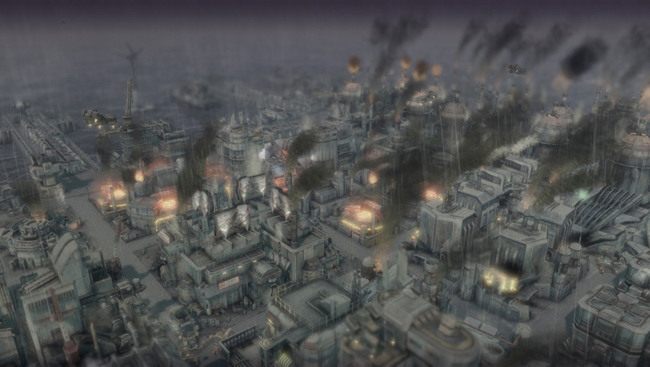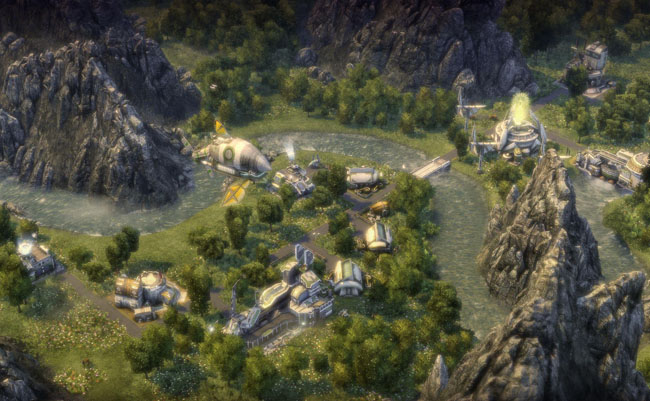The Complexity Budget: Anno 2070
2011, December 29th 2:05 PMI've been spending a lot of time thinking about complexity.
I've also been spending a lot of time playing Anno 2070.
Let's start with Anno 2070.

The game industry is fickle and deadly. Franchises appear out of nowhere, make it big, and instantly fall on their own sword, only to be resurrected in a sort of grisly undead state years later when some publisher realizes they still own the rights. The surviving franchises are either mutated out of recognition within a few years or exploited beyond all sanity. The Anno franchise is an exception. Anno 1602 was released way back in 1998, and it's been followed by four major sequels, two spinoffs, and an expansion pack. Despite this 13-year history, the core game mechanics are unchanged since the very beginning, which makes it absolutely perfect for this discussion.
Unfortunately, I've only played the most recent two games. I'm sure I could say a lot of fascinating things about the entire series of five games, and maybe someday I will, but that's not today. So, instead of talking about the Anno series as a whole, I'm going to talk about the changes between Anno 1404 (known in the US as Dawn of Discovery) and Anno 2070.
Anno is a citybuilding game. There's combat in it, but very little – the core game mechanic is about building a really big city with a whole lot of people and industry. Now, in most games, you'd expect that a city would need a lot of workers in order to run factories and farms. Anno doesn't work that way. Production buildings work whether or not you have people, but they cost money to run. Houses, meanwhile, do only three important things. First, they unlock new technologies and new buildings, based on your population type and your population count. Second, they give you money in taxes, which is needed to keep your cashflow positive and your production functional. Third, they consume the output of those aforementioned production buildings. Playing Anno isn't about balancing Residential, Commercial, and Industrial zones, then watching people move in, it's about building a ton of houses and then trying to keep them fed when they start demanding eighty tons of pasta every minute. And you're the one in charge of the pasta.
(All goods in Anno are measured in tons. This makes perfect sense when talking about wood, coal, or oil, less sense when talking about pasta or glass, and very little sense when talking about diamonds, lobster, or marzipan. You get used to it.)

For a game that's all about production quantities and production chains, Anno 1404 provides very few tools to keep an overview on your industry. In fact, until midway through the game, the only way to count your buildings is to do it manually. To make matters worse, Anno 1404's tech trees can be complicated and interdependent, and figuring out the proper building quantities requires that the player either do a lot of math by hand or use tools.
For example: To run a a wine press at full capacity requires three vineyards, one barrel cooperage, 2/3 of a lumberjack hut, half an iron smelter, half an ore mine, and half a charcoal burner's hut. An Optician's Workshop at full capacity requires 3/4 of a quartz quarry, 3/4 of a copper smelter, 3/4 of a copper mine, and half a charcoal burner's hut. A Redsmith's Workshop requires 1.5 candlemaker's workshops, 2 apiaries, 1.5 hemp plantations, 3/4 of a copper smelter, 3/4 of a copper mine, and 2 charcoal burner's huts. Now: If you want four wine presses, five optician's workshops, and three redsmith's workshops, what buildings do you need?
The answer is "I have no bloody idea, let me alt-tab out to check my Excel spreadsheet".
Even worse than that, however, is the fact that the game doesn't tell you these ratios. I had to look them up. The early tutorial gives you some of the basic ratios – "you will need two hemp plantations for every weaver's hut" – but the complicated stuff has to be determined either by trial and error or by looking it up on a wiki.
Anno 2070's solution to this is . . . incomplete, but an improvement. First, the very first buildings you can construct in Anno 2070 give you access to an easy building-counting station. Apparently they decided that counting buildings manually was boring.
I'm going to pause here, because that last line is the crux of this entire entry. They decided that counting buildings manually was boring. Got a boring mechanic? Take it out! We don't want that here! Every time you get the player to stop doing something that's boring, the player will have more time and more intellect available for things that are interesting. Counting sucks -> get rid of counting.
But they didn't think that calculating building numbers was boring. Now, it's obvious I disagree with this assessment, but I strongly suspect this was an intentional choice of theirs. You can't spend 13 years developing a franchise based around an accidental game mechanic. They also don't seem to think that production numbers are something they need to show. It'd be easy enough for them to do so. As it is, a chunk of the Anno community spends time figuring out the actual production numbers, which the rest of the community embeds into utility programs and the like.

Counting isn't the only interface improvement in Anno 2070. I've mentioned "production buildings", but really there are two important and unique kinds of production buildings – factories and farms. Factories take up a fixed area of land. Farms include a farmhouse, which takes up a small area, and then some number of farm plots – frequently larger than the farmhouse, and always more numerous – which have to be near the farmhouse. Through sheer bulk, the farm plots end up dominating your industry in terms of size, and you spend a good deal of the game time trying to lay out farm plots efficiently.
In Anno 1404, this is somewhat difficult. Farmhouses have a circular zone that you can place plots within, and there's a bit of latitude in how far outside that zone the plots are allowed to go. However, if your farm plots go too far outside the farmhouse radius, they'll produce slightly less efficiently. Remember the mess up there about building production quantities? Imagine if a few of your hemp workshops were running at 90% efficiency. Yeah. You don't want that. To make it even more complicated, some of your farms need to be within range of a water-producing building, which has its own circular radius. To make it even more complicated, you get further bonuses by having overlapping water-producing buildings.
Anno 2070 simplifies things considerably. First, there's no longer such a thing as a water-producing building. Second, while the farm plots still have to be placed nearby, and while the latitude still exists, farm plots placed "close enough" count 100%. Always. You can still be clever and place plots slightly outside the circular range . . . and now that's totally okay! There's no downside! It's just a little extra flexibility you have with placement.
The important thing to realize about complexity is that it's not simply a matter of increasing or reducing complexity. We're not talking about making a decision between Cow Clicker and Paradox Interactive's insane wargame simulators. This is all a matter of moving complexity. I'm going to use the term "complexity budget" – you have only so much space for complexity (both in your game design, and in your poor player's brain) and you have to spend it wisely. Anno 2070 took some of the complexity out of farm placement, which meant they had complexity to spare, which meant they had complexity to spend. And spend it they did!
Anno 1404 has several farm variations. The most common farm is the one that has four 3×4 plots. Later, you find a farm with eight 2×3 plots, as well as the behemoth Cattle Farm that has five 4×4 plots. But that's as weird as it gets – with the exception of the eight 2×3 plot building, every farm has between three and five plots, sized between 3×3 and 4×4.
Anno 2070 goes absolutely insane with farm layouts. Early buildings have a mere two 3×4 plots. The Fruit Plantation has eight 3×3 plots. The Corn Farm requires nine 3×6 plots. 3×6? What the hell is 3×6? And nine of them? Meanwhile, the behemoth Dairy Farm has seven 5×5 plots, making it by far the largest and most irritating structure in the game.
This, right here, is what I mean by the complexity budget. Anno 1404 spent a bunch of complexity on the difficulty of placing farm plots correctly. Anno 2070 threw away that complexity and replaced it with the difficulty of aligning farm plots in efficient patterns. 2070's Dairy Farm would simply be a nightmare to deal with in the world of 1404. With 2070 logic, it's certainly challenging, but it's nowhere near as horrifying as it could be. Moving the complexity out of one area of the game allows you to move it into another area without actually making the game more difficult to deal with – and if you're clever, you've moved it into a more fun location.

2070 moves complexity around in a few other directions as well, though I'm going to go over these quickly. Compared to 1404's Patricians, 2070's Executives are easy to keep happy. The Patricians gain a whopping six new demands at the end of the game, while the Executives only acquire two. But while 1404 has two population types – one complicated type with four stages, one simpler type with two – 2070 has three population types, two with four stages and one with two. The end result is that you spend far less time clawing your way up through the final stage and far more time watching your population upgrade. If 2070's four-stage populations had the complexity of 1404's four-stage population it would just be intimidating.
Finally, 2070 does have a replacement for 1404's water mechanic, but it's a simpler island-wide mechanic. Instead of overlapping circular water radiuses, you can change the ecology of the entire island, anywhere from a polluted hellhole into a glorious green paradise. It's a heavier-weight mechanic – instead of being a little localized effect on certain farms that you can ignore if you don't care, it's something you can and probably will put a significant amount of effort into – but it also has big and, more importantly, predictable results. It's not quite as complicated and minmaxable as 1404's mechanic but it's a lot easier to understand and has simpler ramifications through your supply chain. Anno 2070's water mechanic is made a running theme of the story and set, with a large amount of documentation explaining exactly how it works, while 1404's water mechanic is so undocumented and unintuitive that it's considered by some people to be an exploit – the developers have never fixed it through several major patches and an entire expansion pack.
So. Summary: 2070 takes 1404 and makes incremental improvements to it. They moved complexity out of some mechanics (counting buildings, finicky farm plot placement, water, complex population end requirements) and were able to use that space to add new mechanics (complicated farms, ecology, third population type). The game doesn't feel any more complicated than it did before, but most people seem to feel it's more interesting. Without removing the old things, it may simply have felt overwhelming.
Right now, I think this entry has gone on long enough by far. But we're not done with this subject – oh no, we have quite a lot further to go. We'll be posting more later.

